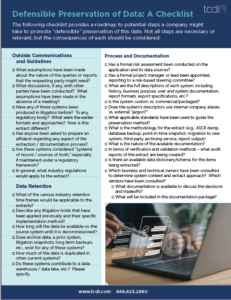You can go the distance
We’ll find out in the long run
We can handle some resistance
If our PRESERVATION is a strong one
(apologies to The Eagles)
Long Term Preservation of Data Sources
Data sources subject to long term preservation and production obligations can present an ongoing burden to the producing party, particularly if the underlying systems have been deprecated, are of legacy status, or are no longer supported by a vendor or internal development team.
While proportionality arguments may carry the day at leading conferences, in the real world, companies are being put to serious decisions about the level of expense and effort required to preserve potentially relevant information over the long term.
In real life, people with knowledge of the system can leave the company or retire, critical documentation may never get recorded, and external vendors can go out of business, become acquired, and/or stop supporting their systems altogether (with essential system knowledge going down with the ship).
The downside of a company adopting a laissez-faire approach? Potential spoliation penalties, adverse inferences, summary judgment motions, and other onerous steps that that court may order. While there are many proactive preservation measures that a company might take, they should meet at least the following criteria:
- Did the company conduct a good faith and meaningful effort to preserve the relevant information, associated business context, and overall “institutional knowledge?”
- Did the company adequately anticipate the various reasonable requests for data, metadata, documentation, interfaces, queries and reports, business rules, and workflows that may issue forth over the life of the associated matter(s)?
- Faced with the hurdles of an unsupported or overly costly legacy system, did the company take reasonable measures to move the information to a more accessible location if the effort was proportional to the anticipated benefit?
- Did the company fully document its decision-making process and the rationale for the chosen course of action?
- Where applicable, has the company leveraged meet and confer and other mechanisms to reach agreement on or refine the scope of preservation and production, such as agreeing on the relevant tables and columns of a database? (Of course, if the requesting party is not immediately known or unified, or if the anticipated dispute can span many years, there may be no one with whom to confer.)
Defensible Preservation of Data: A Checklist
The following checklist provides a roadmap to potential steps a company might take to promote “defensible” preservation of this data. Not all steps are necessary or relevant, but the consequences of each should be considered:
Outside Communications/Guidelines
- What assumptions have been made about the nature of the queries or reports that the requesting party might need?
- What discussions, if any, with other parties have been conducted? What assumptions have been made in the absence of a meeting?
- Have any of these systems been produced in litigation before? To any regulatory body? What were the earlier formats and approaches? How is this extract different?
- Has anyone been asked to prepare an affidavit regarding any aspect of the extraction / documentation process?
- Are these systems considered “systems of record / sources of truth,” especially if maintained under a regulatory framework?
- In general, what industry regulations would apply to the extract?
Data Retention
- What of the various industry retention time frames would be applicable to the extracts?
- Describe any litigation holds that have been applied previously and their specific implementation method?
- How long will the data be available on the source system until it is decommissioned?
- Does archive data, a prior system, litigation snapshots, long term backups, etc., exist for any of these systems?
- How much of the data is duplicated in other current systems?
- Do these systems contribute to a data warehouse / data lake, etc.? Please specify.
Process and Documentation
- Has a formal risk assessment been conducted on the application and its data sources?
- Has a formal project manager or lead been appointed, reporting to a risk-based steering committee?
- What are the full descriptions of each system, including history, business purpose, user and system documentation, report formats, export specifications, etc.?
- Is the system custom vs. commercial/packaged?
- Does the system’s descriptors use internal company aliases vs. external “jargon?”
- What applicable standards have been used to guide the preservation method?
- What is the methodology for the extract (e.g., ASCII dump, database backup, point-in-time snapshot, migration to new system, third party archiving service, report output)
- What is the nature of the available documentation?
- In terms of verification and validation methods – what audit reports of the extract are being created?
- Is there an available data dictionary/schema for the items being extracted?
- Which business and technical owners have been consulted to determine system content and extract approach? Which vendors have been consulted?
- What documentation is available to discuss the decisions and tradeoffs?
- What will be included in the documentation package?
- What is the signoff process for each system?
Privacy and Personally Identifiable Information (PII)
- How is PII and other sensitive data identified and protected in the extract?
- What applicable regulatory standards apply to personal data (e.g., GDPR, CCPA/CPRA, NYS, etc.)
- Has a data classification model been applied to the extracts (e.g., confidential/proprietary, private, sensitive/internal, public)
- If so, how are these levels denoted in the extracts?
- How are source access rights realized in the migration?
- How will sensitive or proprietary data be protected in the extract format?
Source Data Review and Responsibilities
- Who actually performs the migrations and how are results evaluated/tested/compared?
- Are revisions to the migration process and results of test migrations documented?
- Was a complete schema available for the source system? What other documentation is available?
- Did the source system use virtual or computed fields?
- Are any source tables subject to additional third-party licensing/proprietary requirements?
- Were any local extracts made outside the database that might need to be incorporated?
- Were any other supporting systems / websites / data feeds providing input or validation to any of these systems?
- What steps have been taken to assess source data quality?
Mechanics of the Transfer
- Are error logs/exception logs available?
- Are checksums, hash values, record counts, overall size metrics provided?
- What audit trails or logs have made part of the extract?
- Does the documentation include – data entry screens, business roles, report formats/outputs?
- What field mappings have been chosen for each extract?
- Are data transformations occurring in terms of field size, data type, remapping, concatenation, etc.?
- What other business rules were in place in the legacy system and how are they represented?
- Were there database views in place that have been migrated?
- What time stamp information is available to demonstrate when various data elements were migrated?
- Is there a possibility that different tables would be migrated at different times and not be in sync?
- Is an ETL configuration available?
- How are long text/memo/BLOB entries handled as opposed to fixed length fields? How are binary characters addressed?
- Is there any EBCDIC or other non-ASCII coded data? Foreign language characters?
- How are one-to-many or many-to-many relationships treated in the extract process?
- Will specifications be provided as to the extract format, e.g., CSV, tab-delimited, use of special text characters, continuation lines, etc.?
- Are code entries expanded by lookup tables or left as codes?
- Is data “de-normalized” by the extraction, i.e., unique values are repeated for the sake of visibility and reporting?
- Is referential integrity maintained through the extract (e.g., is any data referenced by joins included)?
- What data has NOT been migrated (e.g., system tables, history files, temporary tables, lookup/validation tables)
- Is the source database migrated from a “dump” or live copy?
- How does the migrated system handle queries? reports? purging?






